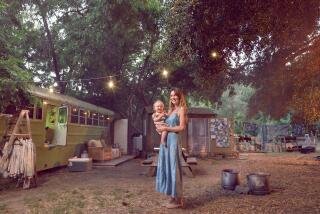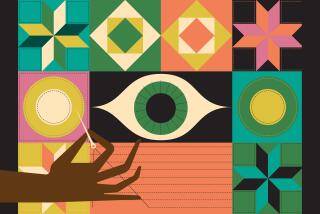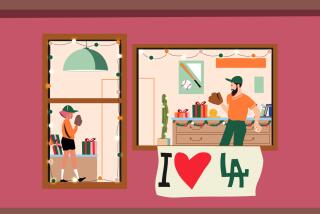Natural dyeing’s future may get brighter with science
A giant steel pot filled with indigo dye is the center of activity at Jane Palmer’s industrial work space, Noon Design Studio and Natural Dye House.
“Today it is indigo, but on any given day, we dye using all natural elements in a variety of interesting shades and colors,” says Palmer as she watches a series of napkins being dip-dyed in the deep shade of blue.
Located in the heart of the garment district downtown, hers is one of a handful of dye houses left in Los Angeles, and it is also part of a shifting, environmentally aware segment of manufacturing in the city. “The colors are soft, they come from nature and there are no harsh chemicals. There is a real demand for this,” Palmer says.
It is this demand that spurred Palmer to try to take the art of natural dyeing, a craft that has stayed relatively the same since its dawn, to the next level.
“I think the main difference in quality between natural and chemical dyes is the colorfastness. Chemical dyes have been formulated to not fade and essentially last forever. Natural dyes have a tendency to lose color more quickly with sunlight and washing,” Palmer says.
So she teamed up with Nina Shapley, an associate professor at Rutgers University’s department of chemical and biochemical engineering. Shapley has been involved in a project on ultraviolet protection of photosensitive molecules. “I was eager to work with Jane to apply our research to a real system,” Shapley says.
Shapley says their aim is to convert natural dyes to particle form, which would help protect against fading due to washing and exposure to light. This would essentially take the water out of the dyeing process, which, during a drought, is high on Palmer’s list of objectives. It would also allow for more fabric to be dyed naturally, increasing the manufacturing potential.
They’ve begun preliminary testing and applied for research funding with the goal of having a working sample by next summer, Palmer says. And although they are still working on the process Shapley is hopeful.
“Basically, Jane is thinking like an engineer in an area that has not been developed much by engineering,” she says. “Her ideas could really make natural dyes competitive in quality with synthetic, chemical dyes and competitive in cost in some targeted markets, where customers value natural materials and a low environmental impact.”
Indigo dyeing is one process that will ultimately stay the same because it does not lend itself to this technology, but other natural elements, including coffee grounds, tea, beets and onion skins, are optimal for this shift.
Palmer sees a vibrancy in natural dyes that makes them attractive. “The colors are alive and awake,” she says.
Besides saving water, Palmer is interested in making good use of plants. She has worked with Edible Gardens Los Angeles to create a line of napkins, linens and aprons using African basil, which is too strong to cook with so is grown simply to attract bees for pollination. “We can make a beautiful emerald green dye with this plant. Up-cycling garden scraps is another important issue to think about.”
Interest in natural dyeing is growing, says Dale Carolyn Gluckman, former curator of costumes and textiles at the Los Angeles County Museum of Art. “The more mechanized, the more industrialized and the more distant we become from the sources of production, the more attractive it becomes,” Gluckman says. “The color quality of natural dyes is so unique, and they come from nature without harming the environment.”
Noon Natural Dye House works with a long list of high-end, boutique clothing and housewares companies, including Dosa, Commune Design, Simon Miller, Rogue Territory, Apolis and Stephen Kenn. “We work with a lot of companies that are environmentally conscious and like the outcome of natural dyeing, but we could do even more if we implement this change in the dyeing process,” Palmer says.


